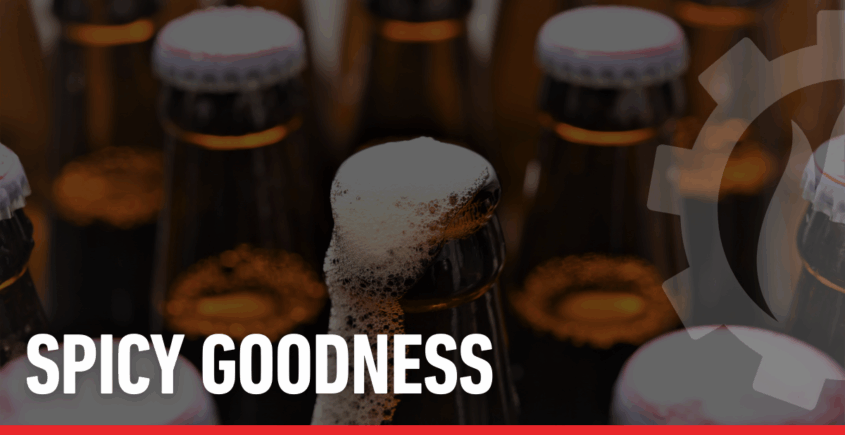Spicy Goodness
When the air turns crisp and the lights start twinkling around town, it’s a sign that the holidays are a comin’. That means rich soups, yummy apps, and mouth-watering pies and other desserts. And for beer lovers, that includes the long-awaited return of Christmas Ale. Spicy, malty, and just a little bit magical, these winter brews have become as much a holiday tradition as gingerbread or mistletoe. While spicy beverages have been around for centuries, there’s something special about Christmas Ale, especially from our neighbors and friends at Great Lakes Brewery here in beautiful Cleveland. But where did they come from, and why do they hold such a special place in our hearts (and pint glasses)? Let’s pour (get it?) into the history, the modern trends, and some top picks for your own Christmas cheer. Sip and Enjoy!

Before holiday beer came with fancy labels, fun can designs, and cinnamon rims, it was born out of necessity and tradition. In ancient Europe, long before hops were widely used, brewers crafted hearty, malt-flavored ales to survive the cold months and to celebrate midwinter festivals. A medieval example, called “lambswool,” was made with roasted apples, nutmeg, ginger, and sugar or honey. Modern recipes often continue this tradition by building on styles like old ale, strong ale, or barley wine.
Ale was an important source of nutrition in the medieval world. It was one of three main sources of grain in the diet at the start of the fourteenth century in England, along with pottage and bread. (my kind of meal!!). Scholars believe grains accounted for around 80% of the calorie intake of agricultural workers and 75% for soldiers – even nobles received around 65% of their calories from grains.
Small beer, also known as table beer or mild beer, which was highly nutritious, contained just enough alcohol to act as a preservative, and provided hydration without intoxicating effects. Small beer would have been consumed daily by almost everyone, including children, in the medieval world, with higher-alcohol ales served for recreational purposes.
Records from the Middle Ages show that ale was consumed in huge quantities. In 1272, a husband and wife who retired at Selby Abbey were given 2 gallons of ale per day with two loaves of white bread and one loaf of brown bread. Monks at Westminster Abbey consumed 1 gallon of ale each day. In 1299, Henry de Lacy‘s household purchased an average of 85 gallons of ale daily, and in 1385–86, Framlingham Castle consumed 78 gallons per day. (wow!! – those monks were rockin’).
Brewing ale in the Middle Ages was a local industry primarily pursued by women. Brewsters, or alewives, would brew in the home for both domestic consumption and small-scale commercial sale. Women dominated the skill and kept things flowing.
By the Middle Ages, monasteries and towns across England, Belgium, and Germany began refining these traditions. Monks, often the best brewers of their day, crafted strong dark ales for winter feasts, sometimes adding herbs, honey, or spices when hops weren’t yet common. These brews were thick, malty, and nourishing — a kind of liquid bread.
As trade expanded and spices like cinnamon, nutmeg, and ginger reached Europe, brewers began experimenting, adding a festive edge to their winter recipes. These additions made the beer taste luxurious, much different than regular beer, creating a special drink for a special time of year.
By the time brewing methods crossed the Atlantic, the idea of a “Christmas ale” was deeply rooted in old-world custom. And centuries later, American craft brewers would rediscover those same malty, spiced, celebratory styles — giving us the beloved seasonal tradition we enjoy today.
Locally, when Great Lakes Brewing Company released its Christmas Ale back in 1992, and at the time was a true leader in the craft beer space. It didn’t just launch a seasonal beer — it kicked off a movement that few breweries were on top of. Brewed with honey, cinnamon, and fresh ginger, it delivered a flavor that was both nostalgic and bold. Locals quickly went wild for it, lining up for fresh pours and grabbing cases to share (or hoard). The beer became a Midwest legend and helped inspire breweries across the U.S. to create their own festive brews.
Over the years, Great Lakes Christmas Ale has collected a sleighful (creative, eh?) of awards, including World Beer Championship gold medals and countless “best seasonal beer” rankings. To “Pair it”, try roasted ham, glazed carrots, or gingerbread cookies — the beer’s malty sweetness and spice play perfectly with savory and dessert flavors alike.
Here are five Christmas ales worth seeking out – whether you’re a spiced beer enthusiast or a curious first-timer.
- Great Lakes Christmas Ale (Cleveland, OH) – The Midwest original, rich with cinnamon and honey. Smooth, balanced, and perfectly festive.
Pair with: Roast turkey, candied yams, or ginger cookies. - Anchor Christmas Ale (San Francisco, CA) – A West Coast tradition since 1975, with a new recipe every year, featuring a secret blend of spices.
Pair with: Sharp cheddar or a winter stew. - Troegs Mad Elf (Hershey, PA) – Sweet and potent, brewed with cherries and honey. This one packs a cheerful punch.
Pair with: Chocolate desserts or soft cheeses. - Sierra Nevada Celebration Ale (Chico, CA) – A hop-forward twist on the Christmas style — bright and citrusy with a malty backbone.
Pair with: Grilled meats or spicy chili. - St. Bernardus Christmas Ale (Belgium) – A rich, dark Belgian ale with notes of caramel, clove, and dark fruit.
Pair with: Fruitcake, blue cheese, or any hearty holiday meal. (To be candid, I will never eat fruitcake while drinking a Christmas Ale – it would be a waste of a good beer!
Beyond their flavor, Christmas Ales are about nostalgia and connection. They remind us to slow down, gather, and savor something crafted with care. Each sip carries the warmth of the season — the same way a good carol or Christmas movie does. It’s also a nod to the creativity of the craft beer world, where brewers take old-world inspiration and give it modern flair. From small-town taprooms to major breweries, Christmas Ales are proof that tradition can evolve and still taste delicious.
Want to bring a little brewery magic home? Host a Christmas Ale tasting! It’s simple, social, and the perfect excuse to gather friends when the weather turns cold. Set the scene: twinkling lights, a crackling fire (or a YouTube one), and a festive playlist. Pair your beers with spiced nuts, cheese boards, smoked meats, and, of course, Holiday/Christmas cookies.
“Great friends, Great beer, and a reason to raise a glass together – that’s what Christmas Ales were made for.”





Leave a Reply
Want to join the discussion?Feel free to contribute!